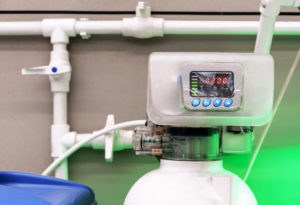
If you have hard water, you may be interested in installing a water softener. After all, “soft” water tastes better, cleans better, and helps your plumbing appliances last longer. However, things get complicated if you have a septic system. Consider the potential negative effects, along with septic-safe practices for using a water softener.
How Water Softeners Work
Typical water softeners use ion exchange to remove minerals from hard water. When water passes through the softener tank, positively charged calcium and magnesium attach to negatively charged resin in the tank. These minerals stay behind, and softened water flows toward plumbing fixtures and appliances.
Once or twice a week, the water softener regenerates the resin by drawing salt water from the brine tank into the softener tank. The ion exchange process happens in reverse, releasing the minerals from the resin and flushing them out through the home’s plumbing system—and into the septic tank, if there is one.
How a Water Softener Can Impact Your Septic System
The water softener regeneration process sends 50 to 150 gallons of brine into your septic tank. This poses two significant problems.
Septic System Overload
Pumping so much water into your septic tank is like taking three to nine showers back-to-back. This can overwhelm the system, especially if your water softener regenerates the same day you run the dishwasher or do a few loads of laundry. An overwhelmed septic system is liable to force solids up through the drain pipes or out into the drain field. Both are messy, expensive problems that you want to avoid at all costs.
Excessive Salt in the Septic Tank
Any excessive influx of water into a septic tank can have negative consequences, but brine is particularly damaging for two reasons:
- Salt water is heavier than fresh water, so it sinks to the bottom of the septic tank. If the sludge layer at the bottom becomes suspended in the effluent layer, solids may flow out to the drain field, clogging the pipes and causing them to fail.
- Salt is corrosive. An excessive amount of brine in your septic tank can corrode the concrete structure and significantly shorten its lifespan.
Using a Water Softener with a Septic System
Many homes with private wells rely on water softeners to remove minerals from the water supply. These same homes also have septic systems. Fortunately, there’s a straightforward option to use your water softener in a septic-safe way—simply set up the water softener to discharge outside the plumbing system, such as into a storm drain or downspout. This allows you to benefit from softer water without introducing brine to your septic tank.
Choose Trinity Liquid Waste for All Your Septic Service Needs
We are a trusted septic system service provider with 25 years of experience aiding residential and commercial customers in San Francisco, CA. We offer septic pumping and routine inspections to keep your system running smoothly. To request your next service, please contact us online or call us at 510-874-6489 today.
““
